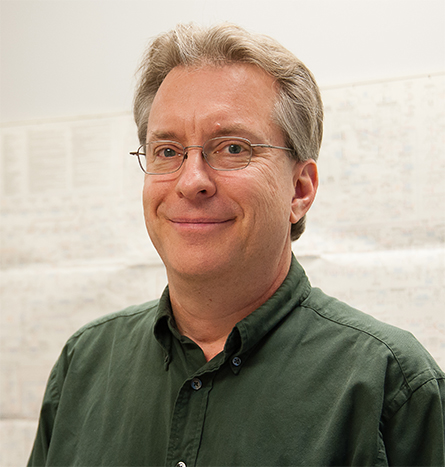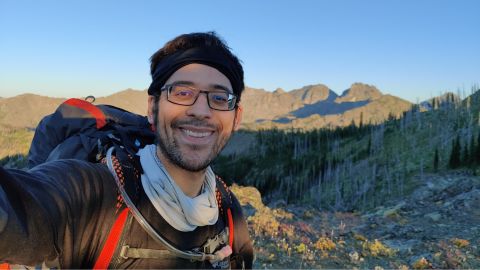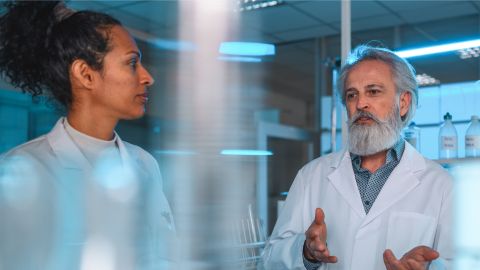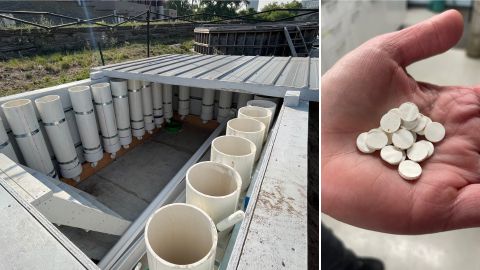“It all comes down to where we place our bets.”
Drug discovery involves coming up with a safe and effective molecule — but first, scientists have to figure out which parts of the cell, when manipulated, give a desired result in disease. Mark Harpel of GlaxoSmithKline is a scientific leader in a unit that does exactly that. He took some time to speak to ASBMB Today about his work; his answers have been condensed and edited.

Name: Mark Harpel
Career path: Ph.D., University of Minnesota, 1990
Postdoctoral research: Postdoctoral research: protein engineering, Oak Ridge National Lab
First job outside academia: DuPont Pharmaceuticals, principal research scientist, chemical enzymology
Favorite molecule or protein: “It’s hard to pick between your children, so I’ll give you two examples: Gentisate 1.2-dioxygenase is the first enzyme I purified from scratch. I started with bacteria, put in a lot of hard work, baby-sat purification columns forever, but in the end, I got a pure piece of biology that alone did a very unique chemical reaction. The second is RuBisCo. It’s a fascinating enzyme, thought to be the world’s most abundant protein because all plants use it to fix carbon dioxide into sugar molecules. But catalytically, it’s a dog of an enzyme. My fundamental (and fun) question was, ‘How do I make this a better carboxylase?’”
I understand that you study novel human genetics. Tell me what that means.
I’m in the novel human genetics research unit at GlaxoSmithKline. GSK, like many companies, is acting on what’s now a general recognition across the industry that a genetic underpinning to drug discovery can increase the chances of success all the way through to product launch. This has made drug companies across the board think differently about how we select targets. To a certain extent, it’s an experiment in progress, but I think there’s a good basis for what we and other companies are doing.
It’s basically acknowledging that one of the most important parts of drug discovery, at least in terms of investment, is getting the target right. We draw on human genetics to pick targets that have a disease basis beyond the theoretical and applied biological work, bringing in actual human data.
Our research unit evaluates targets that come out of genetic analyses and advances them through validation of biological and disease relevance into a discovery program and, if we’re successful, to early clinical studies.
It all comes down to where we place our bets. We use human genetics to help us select targets in, hopefully, a more successful manner but then build the package to further understand them and to identify any early kill experiments that could stop us from investing in something that ultimately will not work out.
What would a kill experiment look like?
Sometimes after running a genomewide association study, we’re pretty sure we have a gene that’s associated with a disease, but we don’t know the directionality. So we design experiments that position us to say whether the hypothesis is good moving forward or the hypothesis is bad. That could be working with primary human cells, for example, to see the effect of reducing the expression of a protein.
It could also be down the road: If we run a high-throughput screen and we don’t get anything out, we’ve either run the wrong screen or the target’s no good. So we have to think about what’s our best screen to interrogate the biology we want to interrogate and set that up as the best decision-making experiment we can do.
You must have a bunch of different projects cooking at once. What does a day in your life look like?
My primary role is as a matrix leader for one program. I set the strategy, get that strategy approved and make sure we have the appropriate resources to fulfill the plan. Then there’s day-to-day coordination and listening to the experts from within and outside GSK who also participate in this program. Of course, as a scientist I enjoy helping to design experiments, discuss incoming data and integrate results across the team.
One of my other primary roles is to evaluate new targets that we get through our internal and external genetic collaborations. We literally get lists of targets to sort through. So honestly, a lot of my day is spent reading journal articles and talking to people. This has been a development area for me. It’s great to not be stuck in your own little niche but to expand your horizons.
I also have opportunities to provide expertise when we do due diligence on business development opportunities, where it all leads up to a recommendation: “Harpel, do you believe this or don’t you believe this?” And that will be at least part of the basis for the investment decision that’s made. So that’s rewarding.
Are you much involved in hiring? What traits do you look for in a potential employee?
It depends on the level. But fundamentally, it has to go beyond the resume. Certainly, the cover letter and resume are the first step; we wouldn’t interview someone unless we saw hints of what was important within the resume. In the interview itself, what’s most important to me is to feel a genuine sense of interest and excitement about the opportunity from that person. That’s my starting point.
The other soft skill I look for in an interview is adaptability. Is a person willing to contribute under conditions that may be changing? Because there’s no guarantee that what we’re doing today will be of interest three months from now. If we find a reason, like in one of those kill experiments I mentioned, why we should not work on something, we’ll walk away from it. There has to be an understanding up front that that could happen. On the other hand, we have to feel that if something is going to progress, you’re going to be all in and support it to your best extent.
When I talk about adaptability, just to be clear, I’m not talking about someone who will sit there and not speak up if they think something is not right. We’re looking for people with opinions, who will say very clearly, “We shouldn’t walk away from (a project) for this reason.” I want to hear that, and so do my colleagues and most of my management. We’re looking for people who are good at speaking their mind but are also willing to listen.
Have there been times when networking really worked out for you?
It’s fair to say that networking does not always work out. Especially if you rely on cold calls, where often you don’t get a response. But I do have a good story. I had an opportunity to either join DuPont Pharmaceuticals or DuPont Basic Research. My contact at DuPont Basic Research was someone I knew from my graduate work: I had met him at various meetings, we talked about our research, we knew each other well. He brought me in to interview for his group, but he made sure my resume made its way up to DuPont Pharma, and they said, “Yeah, we’re kind of interested in this guy as well.” I ended up with a dual interview between the two groups, and then I was presented with an opportunity to go into either industrial enzymology or pharmaceuticals.
Getting to know one person ultimately got me in a position where I had a choice between two jobs. I ended up not working with him directly but still in the same company. I think it really speaks to people wanting to do good things for other people — and it’s how I got into the (pharmaceutical) industry.
Enjoy reading ASBMB Today?
Become a member to receive the print edition monthly and the digital edition weekly.
Learn moreGet the latest from ASBMB Today
Enter your email address, and we’ll send you a weekly email with recent articles, interviews and more.
Latest in Industry
Industry highlights or most popular articles



Strong bonds and a startup
Kevin Lewis’ career path shows that networking is not just about meeting new people to find job leads. Keeping in touch with people from your past can net you opportunities too.

Industry partnership opportunities
The ASBMB has teamed up with Halo to provide ASBMB members fresh industry partnership opportunities each month. The deadline for these is March 31.

Choosing an internship or a fellowship
There are other ways to begin your industry career other than being directly hired to a position. Here we explore the similarities and differences between internships and fellowships in industry.

An academic–industry partnership made possible by Halo
Environmental engineer finds a new use — and new funds — for her lab’s work on a nitrogen-removal system.

